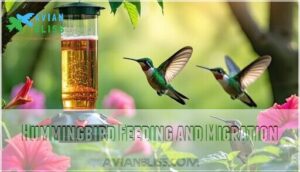This site is supported by our readers. We may earn a commission, at no cost to you, if you purchase through links.

Their early departure also reduces competition, allowing females extra time to fatten up juveniles for the demanding journey ahead. This sex-based migration timing means you’ll notice feeders quieting down in waves during late summer, with males vanishing first while females and young birds linger to build essential fat reserves that can double their body weight for the trek south.
Table Of Contents
- Key Takeaways
- Hummingbird Migration Basics
- Do Male Hummingbirds Migrate First?
- Hummingbird Feeding and Migration
- Hummingbird Migration Routes and Patterns
- Why Do Hummingbirds Migrate?
- How You Can Help Hummingbirds During Migration
- Hummingbird Migration and Behavior
- Frequently Asked Questions (FAQs)
- Do male hummingbirds arrive first?
- Why are there no male hummingbirds at feeders?
- Why do hummingbirds chase each other away?
- Do hummingbirds return to the same area every year?
- How do male hummingbirds interact with other hummingbirds during migration?
- What are the primary threats to male hummingbirds during migration?
- Do hummingbirds migrate at night or day?
- Can hummingbirds recognize individual humans at feeders?
- How do hummingbirds survive storms during migration?
- What predators threaten hummingbirds during their journey?
- Conclusion
Key Takeaways
- Male hummingbirds depart breeding grounds one to two weeks before females and juveniles, racing south to establish territories and claim prime nectar sources along migration routes before competition arrives. – This staggered migration pattern serves dual purposes—males secure dominance at feeding sites while females gain extra time to fatten up their young, with juveniles often building fat reserves that double their body weight for the demanding journey. – You’ll notice feeders quieting in waves during late summer as males vanish first (often by late July), followed by females, with juveniles lingering into September to complete their pre-migration fueling. – Maintaining feeders through September supports both migration waves and proves critical for survival, as these tiny travelers need reliable stopover sites to build the fat reserves necessary for nonstop flights across thousands of miles of mountains, deserts, and open water.
Hummingbird Migration Basics
Hummingbirds time their migrations around when flowers bloom and temperatures shift—pretty predictable stuff once you know the pattern.
Male hummingbirds commonly depart their breeding grounds 1-2 weeks before females and juveniles, establishing territories along migration routes and at wintering destinations.
Ruby-throated Hummingbirds in Northern Illinois
If you’re wondering which hummingbirds grace northern Illinois each spring, you’ll find just one species making the journey—the ruby-throated hummingbird, arriving like clockwork as the last frost melts away.
These striking migrants usually show up in mid-April, so you’ll want your feeders filled and nectar sources ready by April 15th.
Creating a backyard habitat with native flowers aids their migration patterns while helping conservation efforts through citizen science observations.
Migration Patterns and Timing
Hummingbirds don’t pack their bags on the same schedule—migration unfolds in waves that stretch from late summer into mid-fall, shaped by instinct, food supply, and the changing seasons. Male hummingbirds usually depart first, often in late July, while females and juveniles follow weeks later.
What triggers these birds to leave changes depending on where they are and what they need. Shorter days signal it’s time to go, and when flowers start producing less nectar, there’s simply less reason to stick around.
Climate change has been throwing a wrench in these age-old patterns, though—warmer autumns mean some birds leave later than they used to.
Different species also take completely different routes. Ruby-throated Hummingbirds make an incredible nonstop flight across the Gulf of Mexico, while Rufous Hummingbirds prefer the western route and stop several times along the way.
- Migration Speed: Hummingbirds cover up to 23 miles daily during their journey
- Peak timing: Most Hummingbird Migration occurs between August and early October
- Solo travelers: These birds navigate Migration Patterns independently, not in flocks
- Environmental cues: Temperature drops and shorter days trigger departure instincts
Protective Strategies for Migration
Migration isn’t just a mad dash to warmer weather—these tiny birds use surprisingly smart strategies to make it south alive. Male hummingbirds usually go first, scouting conditions before the females take off.
Leaving in waves helps them dodge predators. When birds spread out instead of traveling in one massive group, they don’t become easy targets. It’s a simple tactic that keeps more of them alive.
They’re also masters at conserving energy. Hummingbirds stick to routes they know, hitting reliable food sources along the way. And they’re careful about timing—they wait out bad weather instead of flying straight into storms.
Hummingbird Weight and Flight Capabilities
Despite tipping the scales at just a tenth of an ounce—roughly the weight of a penny—these birds pack enough power to pull off aerial stunts that would make a fighter jet jealous. Their flight muscle mass accounts for nearly 30% of body weight, while wing morphology permits lift generation through figure-eight patterns at 80 beats per second.
So how do they pull it off?
- Metabolism rate: Burns energy 10 times faster than Olympic sprinters during flight.
- Energy storage: Males store fat equal to 40% of body weight before migration.
- Wing efficiency: Four-inch wingspan delivers precision hovering and backward flight.
- Flight speed: Reaches 30 mph, covering 23 miles daily during migration patterns.
Do Male Hummingbirds Migrate First?
Yes, male hummingbirds usually migrate first, departing one to two weeks before females and juveniles. This pattern occurs because males need to establish territories and secure prime feeding spots at their destination before females arrive.
Sex-based Migration Patterns
Yes, male hummingbirds migrate first—a phenomenon you’ll notice if you track arrivals at your feeders. Research shows males usually depart breeding grounds one to two weeks before females, driven by powerful migration triggers tied to photoperiod and territorial instincts.
Spring arrival data confirms males reach destinations up to ten days earlier than females, establishing prime territories before competition heats up. Sex-based routes also differ: mature males often navigate interior mountainous corridors, while females and juveniles favor alternative paths. Plumage differences, navigation cues, and energy reserves all shape these hummingbird migration patterns, with juveniles of both sexes trailing weeks behind adults during fall migration.
Understanding the hummingbird migration patterns is essential for effective conservation and assistance of these birds.
| Category | Males | Females & Juveniles |
|---|---|---|
| Departure Timing | 1-2 weeks earlier | Later by 2-4 weeks |
| Spring Arrival | First to breeding grounds | 1-10 days after males |
| Route Preference | Interior mountains | Coastal/westerly paths |
| Migration Distance | Up to 3,900 miles | Similar distances |
Reasons for Early Male Migration
When males head south ahead of females and juveniles, they’re playing a smart game of timing and territory. By departing roughly one to two weeks earlier—often as soon as July—these birds grab the best feeding spots before competition heats up. Think of it as claiming the best seat in the house before the crowd arrives.
Leaving early isn’t just about beating the rush—it’s a survival strategy that pays off in several ways:
- Territorial Advantage: Males establish and defend prime nectar-rich locations through aggressive displays, securing resources that will attract females during the next breeding season.
- Energy Reserves: Early migration lets them access abundant food sources without competition, building fat stores equal to 25-40% of their body weight for the demanding journey.
- Physiological Adaptations: Their higher metabolism and faster flight capabilities mean they can exploit migration triggers like changing daylength and declining food availability more efficiently.
- Sex-Based Patterns: This staggered departure reduces competition at breeding sites, benefiting the entire population’s survival while giving males first dibs on territory. Understanding their high metabolism needs is vital to grasping the importance of early migration for hummingbirds.
Female and Young Hummingbird Migration Timing
After adult males head south, female hummingbirds and juveniles follow on a staggered schedule, usually departing 7 to 14 days later. This female migration pattern reflects energy accumulation strategies—both groups may double their body weight in two weeks by consuming nectar and insects.
Juvenile departure occurs even later, often 3 to 4 weeks after males leave, as young birds refuel at feeders well into September. These juvenile hummingbirds prefer safer coastal routes, stopping frequently rather than attempting direct Gulf crossings.
Migration triggers like photoperiod and food availability influence when females and young birds begin their journey south, guaranteeing they’re fueled up for the long flight ahead.
Impact of Early Male Migration on Feeders
When male hummingbirds leave your feeders in mid-summer, you’re witnessing nature’s carefully timed relay race. The females and juveniles are waiting in the wings for their turn at the nectar bar.
This migration timing reduces competition at your feeders, allowing younger birds to build necessary fat reserves before their journey. You’ll notice males dominate nectar flow early, often aggressively defending feeder placement.
Their departure enables careful feeder maintenance that aids remaining hummingbirds during this critical wildlife conservation period.
Hummingbird Feeding and Migration
Providing reliable food sources during migration helps hummingbirds maintain the energy they need for their demanding journeys.
You can assist these travelers by offering properly maintained feeders with fresh nectar, following safe recipes and cleaning practices that prevent harmful mold or fermentation.
Nectar Recipe and Safety Precautions
You don’t need fancy ingredients or complicated recipes to keep hummingbirds coming back—just plain white sugar and water will do the trick. Mix one part white sugar with four parts water, and you’re set.
Skip the red dye and artificial sweeteners—these toxic substances can harm hummingbirds during migration.
Change your nectar every few days to prevent mold, keeping your feeder safe for these remarkable travelers as they navigate their journey.
Feeder Maintenance and Cleaning
A dirty feeder can turn your generous offering into a health hazard faster than you’d think, so staying on top of cleaning is just as important as keeping nectar fresh. You’ll want to scrub feeders every few days during peak migration when rubythroated hummingbirds and rufous hummingbirds stop by.
To keep mold at bay:
- Replace sugar water every 3-5 days, more often in hot weather.
- Rinse with hot water and scrub all ports thoroughly.
- Soak in a 1:4 vinegar solution for proper feeder sanitation.
- Dry completely before refilling to prevent bacterial growth.
Hummingbird Attraction to Feeders During Migration
During migration, your feeder becomes a lifeline for hungry hummingbirds covering hundreds or thousands of miles on their journey south. Position feeders in partial shade to prevent nectar spoilage at migration stopovers.
Stick with the standard 4:1 sugar water ratio—skip red dye and artificial sweeteners.
Fresh nectar preferences matter: hummingbirds instinctively seek reliable food sources during bird migration, making your feeder vital for wildlife migration success.
Hummingbird Migration Routes and Patterns
Hummingbirds don’t all follow the same path south—their routes depend on species and where they breed.
Ruby-throated hummingbirds from eastern North America cross the Gulf of Mexico in a single flight, while western species like the Rufous take different corridors along the Pacific coast or through mountain ranges.
Eastern North American Hummingbird Migration
Hummingbirds traveling across Eastern North America chart invisible highways through the sky, retracing ancient pathways that have guided their kind for thousands of years.
These migration routes, particularly the Eastern Flyways, connect breeding grounds with wintering habitats, creating North American corridors that accommodate seasonal patterns.
Male hummingbirds, especially Ruby-throated Hummingbirds, initiate fall migration first, following bird migration patterns shaped by food availability and instinct rather than learned behavior.
Ruby-throated Hummingbird Migration Routes
How do these tiny travelers navigate thousands of miles between their summer breeding grounds and tropical winter homes? Ruby-throated hummingbirds follow distinct flight routes during fall migration, using impressive instinct and environmental cues:
- Adults depart breeding areas in late summer, heading south through established stopover sites
- Many cross the Gulf of Mexico nonstop, a 500-mile journey requiring outstanding energy reserves
- Coastal habitat selection provides critical refueling opportunities before and after water crossings
- Wintering grounds span from southern Mexico through Central America, where food availability remains consistent
These migration patterns demonstrate how ruby-throated hummingbirds balance risk and energy demands during bird migration patterns.
Other Hummingbird Species and Migration Patterns
Ruby-throated Hummingbirds aren’t the only ones making epic journeys. Different species have evolved their own migration strategies based on genetics and where they live.
Take the Rufous Hummingbird—it flies nearly 4,000 miles from Alaska down to Mexico each year. Meanwhile, Anna’s Hummingbirds skip migration entirely and stick to the Pacific Coast year-round. Down in Central America, tropical hummingbirds barely travel at all.
But habitat loss is cutting off traditional routes for many species, so conservationists are now mapping these migration patterns to figure out which stopover sites need protection most.
| Species | Migration Distance | Wintering Location |
|---|---|---|
| Rufous | Up to 3,900 miles | Mexico |
| Black-chinned | Western U.S. to Mexico | Central Mexico |
| Calliope | Northwestern U.S. | Mexico & Guatemala |
Why Do Hummingbirds Migrate?
Hummingbirds migrate because their survival depends on following the blooming cycles of nectar-rich flowers and the availability of insects.
This instinctual journey isn’t triggered by dropping temperatures alone—it’s a finely-tuned response to shortening daylight, dwindling food sources, and internal biological clocks that tell them when it’s time to head south.
Instinctual Migration Timing
What kicks off their migration isn’t just fall arriving—it’s an internal clock that’s been part of their makeup for millennia. These birds have an annual rhythm baked into their genes that flips hormonal switches when it’s time to move.
Days getting shorter and temperatures dropping help sync up that inner timing, so they arrive when food is actually available where they’re headed.
- Male hummingbirds respond earlier to these hormonal triggers, departing first to secure breeding territories
- Navigation instincts guide them along established bird migration patterns without prior experience
- Animal migration patterns show this innate timing maximizes survival across generations
Food Availability and Migration
When nectar sources begin to dwindle, hummingbirds don’t stick around to test their luck—they follow the bloom. Migration success hinges on tracking nectar sources and insect abundance along their routes.
Male hummingbirds often depart during fall migration ahead of females, timing their journey to coincide with peak food sources at stopover sites.
Climate change and habitat loss now disrupt these traditional patterns, forcing hummingbirds to adapt their migration strategies.
Weather and Climate Factors in Migration
Weather shapes every stage of hummingbird migration in ways you mightn’t expect. When temperatures drop to around 35°F in fall, male hummingbirds head out—it’s a physiological trigger that sends them toward their wintering grounds. Climate change is scrambling these patterns. Warmer winters now mean southern birds leave earlier, while northern populations delay their departure.
Here’s what really matters on the journey:
- Droughts and lack of rain wipe out wildflowers along migration routes, leaving birds dependent on feeders
- Hurricanes blow exhausted birds miles off course, and many don’t make it
- Unexpected frosts kill blooming plants right when migrants desperately need fuel
- Cold snaps force birds to burn through their fat reserves fast
Climate change has rewritten the rules entirely. Some species have shifted their routes by 320 miles just to find the resources they need.
Hummingbird Adaptation to Migration
Over millions of years, evolution has equipped these tiny aerial athletes with specialized tools that turn a seemingly impossible journey into a survivable feat. Hummingbirds undergo physiological changes before migration, building fat reserves that double their body weight to fuel flight endurance across vast distances. Their energy efficiency comes from slowing their metabolism during rest stops, while navigation skills rely on magnetic sensing and memory of previous routes.
Adaptation Type Key Feature
Physiological Changes
Energy Efficiency
Navigation Skills
Dietary Adaptations
Flight Endurance
Male hummingbirds demonstrate these ecological adaptations first, departing early to claim prime breeding territories. Their migration patterns show striking precision, with bird migration patterns repeating annually along proven routes.
How You Can Help Hummingbirds During Migration
You can make a real difference for migrating hummingbirds by taking a few simple steps in your own backyard.
Supporting these tiny travelers during their demanding journeys helps guarantee they have the energy and resources needed to complete their migrations successfully.
Providing Nectar-rich Flowers and Feeders
If you want to turn your yard into a rest stop for these extraordinary travelers, setting up nectar-rich flowers and feeders is one of the most effective ways to assist them. You’ll create essential food sources that fuel their amazing journeys.
- Plant native, nectar-rich flowers: Choose trumpet-shaped blooms like salvia and bee balm that bloom sequentially throughout migration season, aiding pollinator gardens and hummingbird behavior patterns.
- Position feeders strategically: Place feeders where you can observe avian ecology interactions while providing shelter from wind and predators.
- Mix proper nectar recipes: Use four parts water to one part white sugar—skip honey or sugar water alternatives that harm hummingbirds.
Creating Hummingbird-friendly Habitats
Want to do more than just hang a feeder? Turn your yard into a real rest stop for migrating hummingbirds by creating spaces that cover all their basics.
Plant native flowers that bloom during migration—these birds know what to look for and rely on those familiar nectar sources. Toss in some water features like misters or shallow fountains. Hummingbirds actually love darting through the spray to clean up.
When you skip the pesticides and choose native plants, you’re not just making your yard prettier—you’re giving these tiny travelers a genuine place to refuel.
| Habitat Element | Why It Matters for Migration |
|---|---|
| Native flowering plants | Provide familiar nectar sources that match natural migration patterns and sustain avian ecology |
| Layered vegetation | Offers shelter from predators and weather while birds rest between flights |
| Water sources | Essential for hydration and bathing, helping maintain feather condition for long-distance travel |
| Pesticide-free zones | Protects insects that supplement hummingbird diets and sustains overall hummingbird behavior |
Avoiding Harmful Substances and Practices
Creating a safe space for hummingbirds means steering clear of dangers that can turn your backyard from a refuge into a hazard—pesticides, dirty feeders, and reflective windows can harm or kill these delicate migrants even when you’re trying to help them. Here’s how you can protect male hummingbirds and other migrants during their journey:
- Pesticide avoidance: Skip chemical sprays that contaminate nectar sources and poison insects hummingbirds eat
- Safe feeder cleaning: Wash feeders with hot water weekly, avoiding soap residues
- Toxic plant awareness: Remove invasive species and plants treated with systemic insecticides
- Window collision prevention: Apply decals or screens to reduce reflective surfaces
- Non-toxic fillers: Use only sugar-water solution—no dyes, honey, or artificial sweeteners
These hummingbird-friendly gardens foster bird conservation and avian behavior studies, helping wildlife ecology experts understand migration patterns better.
Supporting Hummingbird Conservation Efforts
Supporting conservation organizations that protect habitat along migration corridors can make a tangible difference in hummingbird survival.
Your involvement matters—whether through donations, advocacy, or sharing what you’ve learned—because it strengthens the network of people working to preserve these birds and their ecosystems.
- Donate to habitat preservation programs that safeguard nectar sources and nesting areas along migration routes.
- Advocate for ecosystem management policies that limit development in vital hummingbird stopover zones.
- Join conservation biology initiatives monitoring avian populations and migration patterns.
- Share your knowledge about hummingbirds and wildlife protection to inspire community-wide conservation strategies.
Hummingbird Migration and Behavior
During migration, hummingbirds display fascinating social dynamics that differ from their breeding season behavior. While these tiny birds usually travel alone, their interactions at feeding sites reveal complex patterns of territoriality, communication strategies, and navigation techniques that enable their extraordinary journeys across thousands of miles.
Hummingbird Social Behavior During Migration
While you’re focused on keeping feeders filled and gardens blooming, hummingbirds are managing migration with a surprisingly solitary style that defies what you might expect from other migratory birds. Unlike species that rely on flock dynamics and group navigation, hummingbirds migrate alone, following individual migration strategies shaped by their territorial behavior and social hierarchy.
Male hummingbirds, driven by breeding and mating instincts, establish dominance at feeding sites, though they occasionally tolerate females or juveniles nearby. This territoriality and competition reflects bird interactions rooted in survival rather than cooperation.
Aggressive Behavior and Territoriality
Male hummingbirds don’t just defend territory—they transform feeding zones into battle arenas, dive-bombing rivals with startling aggression that can surprise even seasoned birdwatchers. During migration, this territorial behavior intensifies as males establish dominance hierarchies and defend prime nectar sources.
Watch for these aggressive displays:
- High-speed aerial chases reaching 60 mph
- Sharp chirping vocalizations signaling boundary defense
- Threat displays with flared gorgets and spread tail feathers
- Direct physical contact, including mid-air collisions
- Persistent mate competition driving territorial displays
This territoriality ensures males secure resources before females arrive.
Hummingbird Communication and Navigation
Hummingbirds pull off migrations spanning thousands of miles by tapping into at least four different sensory systems at once. Here’s what they’re working with:
- Celestial Navigation: They track the sun’s position and use stars to maintain their flight patterns during long journeys.
- Magnetic Senses: Male hummingbirds and females detect Earth’s magnetic field, functioning like an internal compass for avian migration patterns.
- Visual Landmarks: They recognize topographic features like coastlines and mountain ranges from previous trips.
- Olfaction Cues: Their sense of smell helps identify nectar-rich areas along migration routes.
This multi-layered approach to avian ecology ensures successful navigation across diverse habitats and bird migration patterns.
Unique Hummingbird Migration Strategies
Navigation skills are only part of the story—these tiny birds also pack some extraordinary survival tricks into their migration playbook. Male hummingbirds often pioneer adaptable routes using migration cues like temperature shifts, and certain species like Anna’s employ torpor—a hibernation-like state—to survive spring migration challenges when food becomes scarce.
You’ll find hummingbirds using high-altitude flight patterns to catch favorable winds during fall migration, while some species make non-stop Gulf crossings that demand extreme energy reserves.
Frequently Asked Questions (FAQs)
Do male hummingbirds arrive first?
Regarding timing, male hummingbirds don’t technically arrive first—they depart first. Males leave breeding grounds in late July or early August, establishing territories before females and juveniles follow.
This staggered migration ensures males secure prime feeding spots and breeding sites for the next spring season.
Why are there no male hummingbirds at feeders?
By late summer, adult males have already departed for their southern wintering grounds, usually migrating one to two weeks ahead of females and juveniles.
This staggered departure means your feeders now serve the remaining females and young birds, who are building critical fat reserves before their own demanding journey south.
Why do hummingbirds chase each other away?
Territorial disputes explain why hummingbirds act like tiny, feathered tyrants at your feeder. Aggressive behavior intensifies during migration when competition for nectar fuels their journey.
Males establish feeder dominance through aerial chases, defending resources from rivals in their social hierarchy—pure avian behavior rooted in survival instinct.
Do hummingbirds return to the same area every year?
Year after year, these remarkable birds find their way back to the exact same spots. It’s not luck—hummingbirds have incredible spatial memory that lets them:
- Fly thousands of miles and still remember specific feeding spots from last season
- Pick out individual feeders and flower patches they visited before
- Follow the same routes during spring and fall migrations
This loyalty to familiar places shows just how sharp their minds really are.
How do male hummingbirds interact with other hummingbirds during migration?
Though they’re not exactly carpool buddies, male hummingbirds during migration remain solo travelers, briefly crossing paths at feeders.
At these feeders, territorial displays and social hierarchy quickly emerge through aggressive posturing, before each continues its solitary journey.
Their routes follow ancient migration patterns shaped by avian behavior and habitat needs.
What are the primary threats to male hummingbirds during migration?
During fall migration, male hummingbirds face serious dangers that push their survival skills to the limit. Hawks, shrikes, and roadrunners hunt exhausted migrants. Sudden storms can ground flights or knock birds miles off course.
Habitat loss wipes out the refueling stops they desperately need. Climate change is throwing nectar availability into chaos, leaving birds scrambling for food.
- Predator avoidance from hawks, shrikes, and roadrunners targeting exhausted migrants
- Weather extremes including sudden storms that ground flights or blow birds off course
- Habitat loss eliminating critical refueling stations along Migration Patterns
- Food scarcity and Climate change disrupting nectar availability
Understanding these threats helps Wildlife Conservation efforts protect Male Hummingbirds and advance Avian Ecology research.
Do hummingbirds migrate at night or day?
When observers track Ruby-throated Hummingbirds during fall migration, they notice most travel occurs during daylight hours, with sunrise departures being especially common.
You’ll find these tiny migrants favor daytime flight, allowing them to spot nectar sources and navigate using visual landmarks throughout their spring migration south.
Can hummingbirds recognize individual humans at feeders?
Research suggests you’ll find that hummingbirds can indeed recognize individual humans at feeders.
Their outstanding avian intelligence and hummingbird vision enable facial recall, allowing these extraordinary birds to distinguish between different people based on clothing, behavior, and appearance through repeated human interaction.
How do hummingbirds survive storms during migration?
When severe weather strikes, you’ll find these tiny travelers hunkering down in dense vegetation or sheltered areas. Using their exceptional aerodynamic techniques and wind resistance abilities, they wait out the storm before resuming their fall migration journey.
What predators threaten hummingbirds during their journey?
Although you’ll scan the skies for hawk attacks and falcon dangers, hummingbirds face threats closer to earth during migration. Spiders’ sticky webs ensnare female hummingbirds and juvenile hummingbirds, while snake threats and bat predators lurk at feeders and flowers.
Conclusion
Understanding that male hummingbirds migrate first transforms your backyard into something like a prehistoric watering hole—where timing and territory dictate survival. Males leave breeding grounds one to two weeks early, racing to claim nectar-rich stopover sites before competitors arrive.
Male hummingbirds depart early to claim the best nectar sites before competition arrives, turning migration into a territorial race
This staggered departure lets females focus on fattening up juveniles for their grueling journey south. By maintaining feeders through September, you’re supporting both waves of travelers, guaranteeing each bird builds the critical fat reserves needed to fuel thousands of miles of nonstop flight across mountains, deserts, and open water.
- https://www.rubythroat.org/ObserveArrivalMain.html
- https://news.oregonstate.edu/news/rufous-hummingbirds-migration-looks-different-depending-age-and-sex
- https://journeynorth.org/hummingbirds/news/fall-2019/08272019-males-move-females-and-juveniles-remain
- https://dnr.maryland.gov/wildlife/pages/plants_wildlife/ruby-throated_hummingbird.aspx
- https://www.birdsadvice.com/when-do-hummingbirds-migrate-south/













